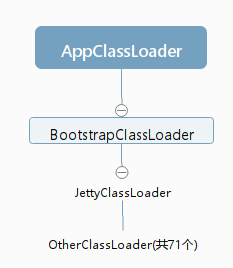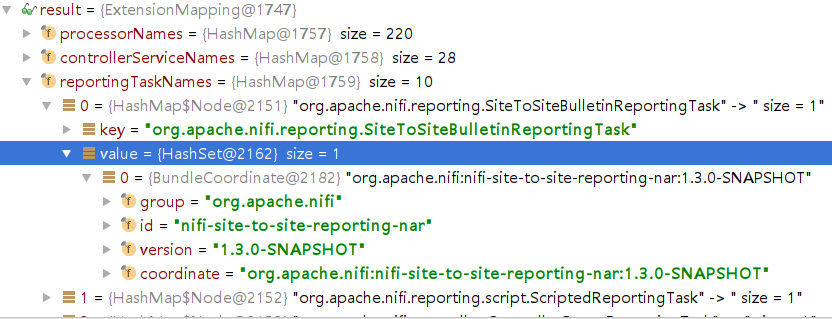研究的源代码版本为1.3.0-SNAPSHOT,使用的环境为linux(fedora 4.7.2-201.fc24.x86_64)
上篇文章说到,从bootstrap启动器,使用Process启动起了org.apache.nifi.NiFi类,这篇文章沿着org.apache.nifi.NiFi的main方法继续向下研读.
该类所做事情大致分为:
- 创建第一个名为bootstrap的classloader,隶属于根classloader.
- 反射org.apache.nifi.properties.NiFiPropertiesLoader类,用于读取conf/nifi.properties配置文件中的配置文件到NiFiProperties结构中.
- 创建与bootstrap启动器的socket通信
- 解压所有的nar插件,并且为其创建单独的classloader
- 启动NiFi的web工程(即NiFi封装的jetty server)
一.为插件机制准备第一个classloader
该classloader为后续所有插件的classloader的父级,这样组织了一个完整的树下来,形式如下:

创建这种classloader的好处是为了隔离不同的nar之间jar错综复杂的依赖关系,这样加载起来的项目运行时,切换到自己的classloader下可以防止出现不可预知的问题.
程序首先创建了bootstrapClassloader,代码如下:
private static ClassLoader createBootstrapClassLoader() throws IOException {
//Get list of files in bootstrap folder
final List<URL> urls = new ArrayList<>();
Files.list(Paths.get("lib/bootstrap")).forEach(p -> {
try {
urls.add(p.toUri().toURL());
} catch (final MalformedURLException mef) {
LOGGER.warn("Unable to load " + p.getFileName() + " due to " + mef, mef);
}
});
//Create the bootstrap classloader
return new URLClassLoader(urls.toArray(new URL[0]), Thread.currentThread().getContextClassLoader());
}
- 程序首先从lib/bootstrap中取出所有的jar包
activation-1.1.jar json-smart-2.1.1.jar antlr-runtime-3.5.2.jar logback-classic-1.2.3.jar asm-1.0.2.jar logback-core-1.2.3.jar asm-3.3.1.jar mail-1.4.7.jar bcpkix-jdk15on-1.55.jar nifi-api-1.3.0-SNAPSHOT.jar bcprov-jdk15on-1.55.jar nifi-bootstrap-1.3.0-SNAPSHOT.jar commons-codec-1.10.jar nifi-expression-language-1.3.0-SNAPSHOT.jar commons-lang3-3.5.jar nifi-properties-loader-1.3.0-SNAPSHOT.jar jackson-annotations-2.6.0.jar nifi-security-utils-1.3.0-SNAPSHOT.jar jackson-core-2.6.1.jar nifi-utils-1.3.0-SNAPSHOT.jar jackson-databind-2.6.1.jar okhttp-3.6.0.jar jna-4.4.0.jar okio-1.11.0.jar jna-platform-4.4.0.jar slf4j-api-1.7.25.jar json-path-2.0.0.jar - 创建父classloader为AppClassloader的,并且将上述的所有jar包加入到该classloader的classpath中,至此,bootstrapClassloader创建完成.
二.加载conf/nifi.properties配置文件中的配置
程序使用反射的机制,加载起org.apache.nifi.properties.NiFiPropertiesLoader类,使用该类的get方法获取配置信息.
Thread.currentThread().setContextClassLoader(boostrapLoader);
final Class<?> propsLoaderClass = Class.forName("org.apache.nifi.properties.NiFiPropertiesLoader", true, boostrapLoader);
final Method withKeyMethod = propsLoaderClass.getMethod("withKey", String.class);
final Object loaderInstance = withKeyMethod.invoke(null, key);
final Method getMethod = propsLoaderClass.getMethod("get");
final NiFiProperties properties = (NiFiProperties) getMethod.invoke(loaderInstance);
LOGGER.info("Loaded {} properties", properties.size());
return properties;
通过代码我们可以看到,当前的classloader被切换到了bootstraploader上,因为NiFiPropertiesLoader类属于nifi-properties-loader-1.3.0-SNAPSHOT.jar,然后调用get方法获取回所有的配置信息. 具体的读取配置的代码不再详述,有兴趣的可以自行debug…
上篇文章中有描述org.apache.nifi.NiFi类被启动的脚本为:
java -classpath /backup/nifi-1.3.0-SNAPSHOT/./lib/nifi-properties-1.3.0-SNAPSHOT.jar org.apache.nifi.NiFi
这里我们可以看到,其实在AppClassloader中,已经存在了所有的lib/bootstrap中的依赖,且和bootstraploader中的urls一致,不知道为什么单独干一层bootstrap.
三.程序的完整及健壮的保证
-
创建shutdownhook
在org.apache.nifi.NiFi这个虚拟机关闭之前优雅的去关闭掉NiFi的web容器,以及关闭掉与bootstrap启动器通信的socket线程.具体如何创建的,后续慢慢叙述,这里只是做了优雅关闭的功能. -
创建与bootstrap启动器的socket通讯
serverSocket = new ServerSocket(); serverSocket.bind(new InetSocketAddress("localhost", 0)); serverSocket.setSoTimeout(2000); final int localPort = serverSocket.getLocalPort(); logger.info("Started Bootstrap Listener, Listening for incoming requests on port {}", localPort); listener = new Listener(serverSocket); final Thread listenThread = new Thread(listener); listenThread.setDaemon(true); listenThread.setName("Listen to Bootstrap"); listenThread.start(); logger.debug("Notifying Bootstrap that local port is {}", localPort); sendCommand("PORT", new String[] { String.valueOf(localPort), secretKey});做的事情不是很复杂,首先在本地创建一个socketserver,然后建立与bootstrapserver的链接,之后将自己的端口发送到bootstrap.
case "PORT": { if (args.length != 2) { throw new InvalidCommandException(); } final int port; try { port = Integer.parseInt(args[0]); } catch (final NumberFormatException nfe) { throw new InvalidCommandException("Invalid Port number; should be integer between 1 and 65535"); } if (port < 1 || port > 65535) { throw new InvalidCommandException("Invalid Port number; should be integer between 1 and 65535"); } final String secretKey = args[1]; runner.setNiFiCommandControlPort(port, secretKey); writer.write("OK"); writer.newLine(); writer.flush(); } break;服务器收到消息之后,存储这个port,然后回复OK,基本的通讯就告一段落了.
四.解压所有插件,并且创建对应的classloader
- 解压所有nar包
private static File unpackNar(final File nar, final File baseWorkingDnarDependencyCoordinateirectory) throws IOException { final File narWorkingDirectory = new File(baseWorkingDirectory, nar.getName() + "-unpacked"); // if the working directory doesn't exist, unpack the nar if (!narWorkingDirectory.exists()) { unpack(nar, narWorkingDirectory, calculateMd5sum(nar)); } else { // the working directory does exist. Run MD5 sum against the nar // file and check if the nar has changed since it was deployed. final byte[] narMd5 = calculateMd5sum(nar); final File workingHashFile = new File(narWorkingDirectory, HASH_FILENAME); if (!workingHashFile.exists()) { FileUtils.deleteFile(narWorkingDirectory, true); unpack(nar, narWorkingDirectory, narMd5); } else { final byte[] hashFileContents = Files.readAllBytes(workingHashFile.toPath()); if (!Arrays.equals(hashFileContents, narMd5)) { logger.info("Contents of nar {} have changed. Reloading.", new Object[] { nar.getAbsolutePath() }); FileUtils.deleteFile(narWorkingDirectory, true); unpack(nar, narWorkingDirectory, narMd5); } } } return narWorkingDirectory; }这里其实没做太多的工作,主要是验证一下md5文件是否一致,不一致的时候就说明有改动需要重新加载.
- 获取nar中的基本信息,并且封装成ExtensionMapping结构
final Attributes attributes = manifest.getMainAttributes(); final String groupId = attributes.getValue(NarManifestEntry.NAR_GROUP.getManifestName()); final String narId = attributes.getValue(NarManifestEntry.NAR_ID.getManifestName()); final String version = attributes.getValue(NarManifestEntry.NAR_VERSION.getManifestName());这里还做了nar类型的分类,具体如图:

- 创建classloader
// see if this class loader is eligible for loading ClassLoader narClassLoader = null; if (narDependencyCoordinate == null) { narClassLoader = createNarClassLoader(narDetail.getWorkingDirectory(), jettyClassLoader); } else { final String dependencyCoordinateStr = narDependencyCoordinate.getCoordinate(); // if the declared dependency has already been loaded if (narCoordinateClassLoaderLookup.containsKey(dependencyCoordinateStr)) { final ClassLoader narDependencyClassLoader = narCoordinateClassLoaderLookup.get(dependencyCoordinateStr); narClassLoader = createNarClassLoader(narDetail.getWorkingDirectory(), narDependencyClassLoader); } else { // get all bundles that match the declared dependency id final Set<BundleCoordinate> coordinates = narIdBundleLookup.get(narDependencyCoordinate.getId()); // ensure there are known bundles that match the declared dependency id if (coordinates != null && !coordinates.contains(narDependencyCoordinate)) { // ensure the declared dependency only has one possible bundle if (coordinates.size() == 1) { // get the bundle with the matching id final BundleCoordinate coordinate = coordinates.stream().findFirst().get(); // if that bundle is loaded, use it if (narCoordinateClassLoaderLookup.containsKey(coordinate.getCoordinate())) { logger.warn(String.format("While loading '%s' unable to locate exact NAR dependency '%s'. Only found one possible match '%s'. Continuing...", narDetail.getCoordinate().getCoordinate(), dependencyCoordinateStr, coordinate.getCoordinate())); final ClassLoader narDependencyClassLoader = narCoordinateClassLoaderLookup.get(coordinate.getCoordinate()); narClassLoader = createNarClassLoader(narDetail.getWorkingDirectory(), narDependencyClassLoader); } } } } } // if we were able to create the nar class loader, store it and remove the details final ClassLoader bundleClassLoader = narClassLoader; if (bundleClassLoader != null) { narDirectoryBundleLookup.put(narDetail.getWorkingDirectory().getCanonicalPath(), new Bundle(narDetail, bundleClassLoader)); narCoordinateClassLoaderLookup.put(narDetail.getCoordinate().getCoordinate(), narClassLoader); narDetailsIter.remove(); }这里的创建其实分为两种情况,对于子项目和非子项目,非子项目的直接创建,子项目的稍微复杂一些,要验证这个所属项目是否已经创建了,父项目还没有创建的时候,子项目等待.最后保存成InitContext结构:

五.启动NiFiServer
// load the server from the framework classloader
Thread.currentThread().setContextClassLoader(frameworkClassLoader);
Class<?> jettyServer = Class.forName("org.apache.nifi.web.server.JettyServer", true, frameworkClassLoader);
Constructor<?> jettyConstructor = jettyServer.getConstructor(NiFiProperties.class, Set.class);
final long startTime = System.nanoTime();
nifiServer = (NiFiServer) jettyConstructor.newInstance(properties, narBundles);
nifiServer.setExtensionMapping(extensionMapping);
nifiServer.setBundles(systemBundle, narBundles);
先切换到frameworkClassLoader,这里在上面的图片中可以看到,就是nifi-framework-nar工程的classloader,然后实例化jettyserver,封装到nifiserver类中,
nifiServer.start();
if (bootstrapListener != null) {
bootstrapListener.sendStartedStatus(true);
}
final long endTime = System.nanoTime();
LOGGER.info("Controller initialization took " + (endTime - startTime) + " nanoseconds.");
这里调用nifiServer.start()开始真正的启动了web工程,具体细节的启动流程在之后文章里详细讲解.启动之后,向bootstrap启动器发送”STARTED”命令.